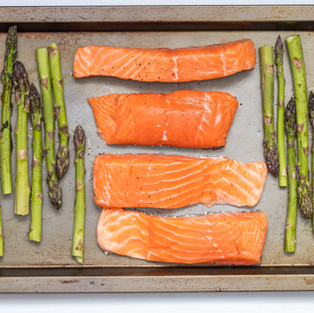New research shows surprising differences between salmon species
- Nancy Tran

- Feb 3, 2021
- 4 min read
As I was shopping at Costco Canada and I came across an "organic" labelled salmon. This was a great find, so I thought I would share this find on my Instagram story. I quickly received a random person's message stating that "Organic doesn't mean wild, it just means fed organic food. This is still terrible salmon! Not to mention the negative impacts open-net fish farms have on ocean environments."
So I decided to do some research on these topics. I came across the Journal of Agriculture and Food Research article on investigating the nutritional composition of different salmon types available to Canadian consumers. (Dated December 2020)
Salmon is well known to provide a range of valuable nutrients, including omega-3 fatty acids and protein. However, it may not be obvious to consumers to know which species offers the highest nutrition level when faced with several salmon types in the grocery store.
There are also mixed messages regarding farmed (organic labelled) salmon, which some people believe may contain contaminants and are not as nutritious as wild fish.
Consumers cannot rely on labels for clarity, as nutritional information on seafood packaging in Canada and the United States is not required.
Stefanie Colombo, an Assistant Professor of Aquaculture at Dalhousie University's Agriculture Campus, wanted to shed some light on the muddy area by exploring the nutritional differences between salmon types. Her research, recently published in the Journal of Agriculture and Food Research, has produced some surprising findings that she hopes may dispel misunderstandings about farmed salmon.
"I get many questions from people I meet about farmed salmon, and many people have the idea that it's not good for you, that it's full of fat and contaminants," says Dr. Colombo, who also holds the Canada Research Chair in Aquaculture Nutrition. "I knew these were misconceptions, but I wanted to know how it was compared to the other types of salmon that were out there. I was surprised by a few things. It's really the salmon species that makes the biggest difference in nutritional quality—not whether it was farmed or wild-caught, or whether it was certified organic or environmentally certified. For example, there was a big difference in the wild salmon we were looking at—between Sockeye, Chinook and Pacific. The results showed clearly that the types of salmon are different."
Store-purchased salmon testing
The study involved purchasing six different salmon types commonly available to Canadians to compare nutritional information for each type, focusing particularly on omega-3s. The fish included farmed Atlantic, farmed organic Atlantic, farmed organic Chinook, wild Chinook, wild pink Pacific and wild Sockeye.
The team brought all the samples back to the Dal Agricultural Campus in Truro, processed the filets and carried out various nutritional and mercury analyzes. Dr. Colombo tested the different salmon species: wild, farmed, organic, non-organic, environmentally certified and non-environmentally certified.
Dr. Colombo found that the more expensive wild sockeye, which could be $31.50/lb, and wild chinook, had the most nutrient-dense and the highest omega-3 content. But it also found that farmed Atlantic salmon, which cost about $12.50/lb, had the lowest mercury content, had a high nutrient density, was more affordable and available on both coasts of Canada.
"There's actually no other study out there that has done this for Canadian salmon," she says. "There have been studies that focus on the contaminants, but they are several years old, and things have changed in the environment and aquaculture. So, it was an exciting opportunity to do an investigation!"
Helping consumers to choose
Dr. Colombo points out that the material may be useful for consumers looking for nutritional information on salmon while at the same time clearing up confusion about the distinction between wild and farmed fish.
Based on these results, sockeye and chinook can be consumed less frequently at the same nutritional value. However, they are expensive, and there are limits to sustainable catch levels. But if you enjoy eating salmon more often, Dr. Colombo says farmed Atlantic is a great option for its nutritional value, cost, availability and low mercury content.
Aquaculture supplies around 50 percent of the world's fish for human consumption, with Canada being the fourth-largest producer of salmon in the world, behind Norway, Chile and the United Kingdom. According to the paper, the volume of farmed Atlantic salmon has increased by 800 percent since 1990, with 72 percent of the salmon we eat today being farm-raised.
Research funded by the Natural Sciences and Engineering Research Council of Canada (NSERC) Discovery Grant may also provide policymakers with important information on the nutritional value and possible future labelling of fish that is linked to improved cardiovascular and neurological health, the development of visual capabilities, and brain development in fetuses.
"The situation with regards to traceability and labelling is evolving, and I think we'll see more labelling for agricultural products in the future—this paper can be helpful for policymakers to review the current data on the vast differences in the nutritional content of salmon," says Dr. Colombo.
The University of Dalhousie provided this information. The article was written on 10 July 2020.
Reference: https://phys.org/news/2020-07-reveals-differences-salmon-species.html










Comments